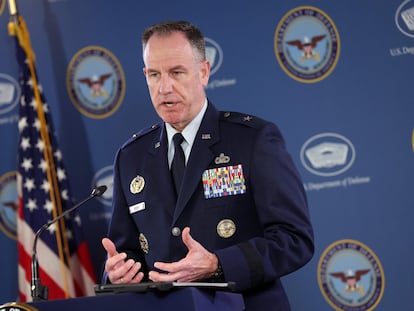‘It just rang’: In crises, US-China hotline goes unanswered
Chinese Defense Minister Wei Fenghe declined to get on the line, the Pentagon says

Within hours of an Air Force F-22 downing a giant Chinese balloon that had crossed the United States, Defense Secretary Lloyd Austin reached out to his Chinese counterpart via a special crisis line, aiming for a quick general-to-general talk that could explain things and ease tensions.
But Austin’s effort Saturday fell flat, when Chinese Defense Minister Wei Fenghe declined to get on the line, the Pentagon says.
China’s Defense Ministry says it refused the call from Austin after the balloon was shot down because the U.S. had “not created the proper atmosphere” for dialogue and exchange. The U.S. action had “seriously violated international norms and set a pernicious precedent,” a ministry spokesperson was quoted as saying in a statement issued late Thursday.
It’s been an experience that’s frustrated U.S. commanders for decades, when it comes to getting their Chinese counterparts on a phone or video line as some flaring crisis is sending tensions between the two nations climbing.
From Americans’ perspective, the lack of the kind of reliable crisis communications that helped get the U.S. and Soviet Union through the Cold War without an armed nuclear exchange is raising the dangers of the U.S.-China relationship now, at a time when China’s military strength is growing and tensions with the U.S. are on the rise.
Without that ability for generals in opposing capitals to clear things up in a hurry, Americans worry that misunderstandings, false reports or accidental collisions could cause a minor confrontation to spiral into greater hostilities.
And it’s not about any technical shortfall with the communication equipment, said Bonnie Glaser, managing director of Indo-Pacific studies at the German Marshall Fund think tank. The issue is a fundamental difference in the way China and the U.S. view the value and purpose of military-to-military hotlines.
U.S. military leaders’ faith in Washington-to-Beijing hotlines as a way to defuse flare-ups with China’s military has been butting up against a sharply different take — a Chinese political system that runs on slow deliberative consultation by political leaders and makes no room for individually directed, real-time talk between rival generals.
And Chinese leaders are suspicious of the whole U.S. notion of a hotline — seeing it as an American channel for trying to talk their way out of repercussions for a U.S. provocation.
“That’s really dangerous,” Assistant Secretary for Defense Ely Ratner said Thursday of the difficulty of military-to-military crisis communications with China, when Democratic Sen. Jeff Merkley pressed him about China’s latest rebuff on Beijing’s and Washington’s hotline setup.
U.S. generals are persisting in their efforts to open more lines of communication with Chinese counterparts, the defense official said, testifying before the Senate Foreign Relations Committee. “And unfortunately, to date, the PLA is not answering that call,” Ratner said, referring to China’s People’s Liberation Army.
Ratner accused China of using vital channels of communication simply as a blunter messaging tool, shutting them down or opening them up again to underscore China’s displeasure or pleasure with the U.S.
China’s resistance to military hotlines as tensions increase puts more urgency on efforts by President Joe Biden and his top civilian diplomats and security aides to build up their own communication channels with President Xi Jinping and other top Chinese political officials, for situations where military hotlines may go unanswered, U.S. officials and China experts say.
Both U.S. and Chinese militaries are building up for a possible confrontation over U.S.-backed self-ruled Taiwan, which China claims as its territory. The next flare-up seems only a matter of time. It could happen with an expected event, such as House Speaker Kevin McCarthy’s promised visit to Taiwan, or something unexpected, like the 2001 collision between a Chinese fighter and a U.S. Navy EP-3 reconnaissance plane over the South China Sea. Without commanders talking in real-time, Americans and Chinese would have one less way of averting greater conflict..
“My worry is that the EP-3 type incident will happen again,” said Lyle Morris, a country director for China for the Office of the Secretary of Defense from 2019 to 2021, now a senior fellow at the Asia Society Policy Institute. “And we will be in much different political environments of hostility and mistrust, where that could go wrong in a hurry.”
Biden has emphasized building lines of communications with China to “responsibly manage” their differences. A November meeting between Xi and Biden yielded an announcement the two governments would resume a range of dialogues that China had shut down after an August Taiwan visit by then-House Speaker Nancy Pelosi.
Last weekend, the U.S. canceled what would have been a relationship-building visit by Secretary of State Antony Blinken after the transit of the Chinese balloon, which the U.S. says was for espionage. China claims it was a civilian balloon used for meteorological research.
The same week that China’s balloon flew over the U.S., Austin was in the Philippines to announce an expanded U.S. military footprint there, neighboring China, noted Tiehlin Yen, director of the Taiwan Center for Security Studies, a think tank. “America is also very nationalistic these days,” Yen said.
“From a regional security perspective, this dialogue is necessary,” Yen said.
What passes for military and civilian hotlines between China and the U.S. aren’t the classic red phones on a desk.
Under a 2008 agreement, the China-U.S. military hotline amounts to a multistep process by which one capital relays a request to the other for a joint call or videoconference between top officials on encrypted lines. The pact gives the other side 48 hours and up to respond, although nothing in the pact stops top officials from talking immediately.
Sometimes when the U.S. calls, current and former U.S. officials say, Chinese officials don’t even pick up.
“No one answered. It just rang,” recounted Kristen Gunness, a senior policy analyst at the Rand Corporation. Gunness was speaking about a March 2009 incident when she was working as an adviser to the Pentagon’s chief of naval operations. Chinese navy vessels at the time surrounded a U.S. surveillance ship in the South China Sea and demanded the American leave. U.S. and Chinese military officials eventually talked - but some 24 hours later.
It took decades of Washington pushing to get Beijing to agree to the current system of military crisis communications, said David Sedney, a former deputy assistant secretary of defense who negotiated it.
“And then once we had it in place, it was clear that they were very reluctant to use it in any substantive purpose,” Sedney said.
Americans’ test calls on the hotline would get picked up, he said. And when Americans called to give congratulations on some Chinese holiday, Chinese officials would pick up and say thanks, he said.
Anything more sensitive, Sedney said, the staffers answering the phone “would say, ‘We’ll check. As soon as our leadership is ready to talk, we’ll get back to you.’ Nothing would happen.”
Sign up for our weekly newsletter to get more English-language news coverage from EL PAÍS USA Edition
Tu suscripción se está usando en otro dispositivo
¿Quieres añadir otro usuario a tu suscripción?
Si continúas leyendo en este dispositivo, no se podrá leer en el otro.
FlechaTu suscripción se está usando en otro dispositivo y solo puedes acceder a EL PAÍS desde un dispositivo a la vez.
Si quieres compartir tu cuenta, cambia tu suscripción a la modalidad Premium, así podrás añadir otro usuario. Cada uno accederá con su propia cuenta de email, lo que os permitirá personalizar vuestra experiencia en EL PAÍS.
¿Tienes una suscripción de empresa? Accede aquí para contratar más cuentas.
En el caso de no saber quién está usando tu cuenta, te recomendamos cambiar tu contraseña aquí.
Si decides continuar compartiendo tu cuenta, este mensaje se mostrará en tu dispositivo y en el de la otra persona que está usando tu cuenta de forma indefinida, afectando a tu experiencia de lectura. Puedes consultar aquí los términos y condiciones de la suscripción digital.
More information
Archived In
Últimas noticias
The complicated life of Francesca Albanese: A rising figure in Italy but barred from every bank by Trump’s sanctions
How Japan is trying to avert ‘digital defeat’
Half of Scotland is in the hands of 420 property owners
Reinhard Genzel, Nobel laureate in physics: ‘One-minute videos will never give you the truth’
Most viewed
- Pablo Escobar’s hippos: A serious environmental problem, 40 years on
- Reinhard Genzel, Nobel laureate in physics: ‘One-minute videos will never give you the truth’
- Why we lost the habit of sleeping in two segments and how that changed our sense of time
- Charles Dubouloz, mountaineering star, retires at 36 with a farewell tour inspired by Walter Bonatti
- The Florida Keys tourist paradise is besieged by immigration agents: ‘We’ve never seen anything like this’










































